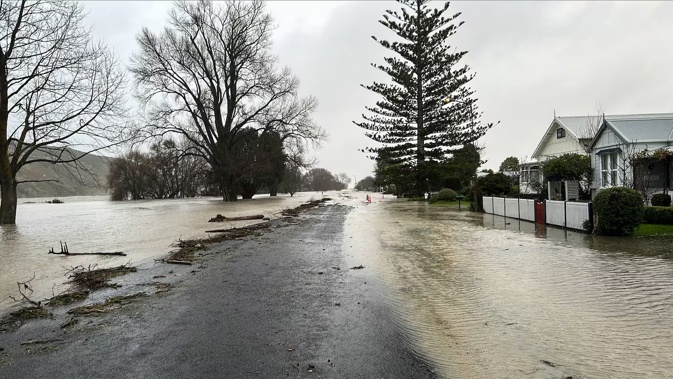

Kerry Tong’s Category 3 land in Eskdale is a thorn in his side.
He claims agents handling the buyout of his cyclone-destroyed property told him his best bet would be to take the relocation offer and keep the land.
“They said my rates would be minimal,” Tong said.
They weren’t.

Kerry Tong is being charged pre-cyclone rates for this Category 3 land in Eskdale.
However, a spokesperson for the Hastings District Council says the Property Group acted as agents for the council and was unaware of any advice given regarding ongoing rates obligations.
“The voluntary buyout policy developed and approved by council and jointly funded by both the Government and council, set out a process for how it would work,” the spokesperson said.
“Incorporated in that was a differentiation between properties under 2ha and those over 2ha. For those smaller properties owners had the option of selling their land to the council or taking a relocation grant and retaining ownership of the land.
“Council also provided financial support to property owners to get their own expert advice including legal support.
“Where property owners decided to take the relocation grant, they retained ownership of the land and with that the opportunities that may arise in the future for that land to be sold or utilised for other purposes.
“However, with continued ownership came responsibilities like looking after the land and paying rates like most other property owners.”
An increasing number of cyclone victims have spoken out about being charged the same rates for Category 3 land.
They include Pākōwhai landowners who claim their properties, parts of which encroach on the edge of the red zone known as Category 3 brought in after the cyclone, are now worth hundreds of thousands of dollars less, yet they are still being charged the same rates as before the cyclone.
Tong said that as soon as he received the rates bill for $1400, he stopped his automatic payment.
“I’m not paying it. I’ll fight it. How can they charge full rates when they know the land is worth virtually nothing?
“It’s bloody rude.”
Wairoa resident Hinerangi (Marie) Tuahine's home was flooded in the June floods of 2024. The latest QV has halved the value of her property. Photo / Hawke's Bay Regional Council
In Wairoa, residents are facing a similar dilemma with new rating valuations prepared by independent valuers Quotable Value (QV) on behalf of the Wairoa District Council wiping thousands of dollars from some property values.
Hinerangi Tuahine has lived in her Wairoa home for “50-odd years”.
It was flooded in June last year.
“Times are tough and three months before the floods I was thinking of stopping my insurance. I’d been paying it for 50 years and had only claimed on a couple of small things.
“I didn’t get around to it. I think someone was watching over me.”
The repairs to her home cost $234,000.
Her last valuation was $205,000. Her new one released in February, is $100,000, less than half of what it cost to repair her home.
“Everyone was shocked at the valuations. We are facing another rate rise this year. I think it’s unfair we have lost so much value and yet we still have to pay higher rates.”
Wairoa Mayor Craig Little said drops in QV valuations have occurred in many places across New Zealand,
“Wairoa isn’t unique,” he said.
“Valuations do not affect the amount of money a council collects from rates - it is a tool that helps the council work out everyone’s share of rates.
“An increase or decrease in your property value may not mean you pay more or less in rates. Any rate change is determined by your new property value compared with the new average across the district.
“Every year, the council looks at what it will cost to run the district and subtracts revenue from fees and other sources. This leaves the total amount of rates needed to run the district. That rate requirement is then shared across the district based on each property’s capital value.”
A spokesperson for the Hawke’s Bay Regional Council says it continues to grant rating relief based on several factors including financial hardship.
“This is by way of annual application, which allows us on a case-by-case basis, to review the progress of restoration of dwellings and productive land, and assess the appropriate level of financial assistance.”
The Hastings council spokesperson said it could not ”just reduce people’s rates.”
“There are clear and defined processes for how rates are calculated and struck, and once that has been done at the start of each financial year there is very little the council can do to reduce them.
“The council is, however, required to have a rates remission policy and a rates postponement policy.
“The rates remission policy sets out how rates can be remitted [reduced]. Any application a ratepayer makes to have their rates remitted, either partially or wholly, must be assessed against that policy and any changes to that policy can only be made following full public consultation and normally occurs when a long-term plan is being consulted on.
“Rates remissions are funded by the broader ratepayers.”
Napier MP Katie Nimon said councils are accountable to their communities for their operational policies and decisions (including the settings of rates) rather than the Minister of Local Government.
“Local authorities are responsible for deciding what mix and level of rates best suits their communities, following consultation with ratepayers and residents.
“They can adjust liability for rates to recognise factors such as location, availability of services and community expectations. The provisions in the Local Government (Rating) Act 2002 recognise that each city and district is unique and are intended to give individual councils the flexibility to decide on the arrangements that best fit local circumstances.”
LDR is local body journalism co-funded by RNZ and NZ On Air.
Take your Radio, Podcasts and Music with you









